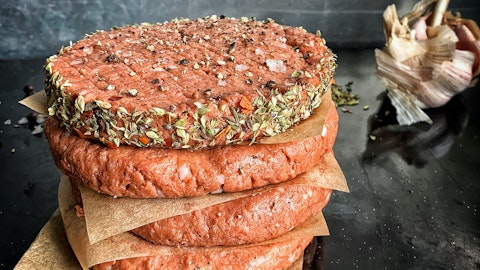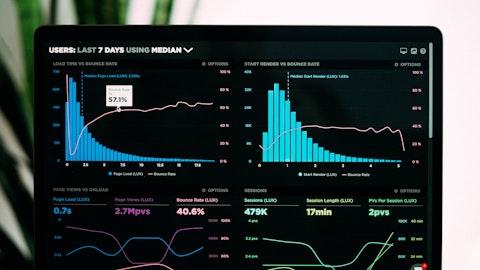Unilever PLC (NYSE:UL) Q3 2023 Earnings Call Transcript October 27, 2023
Hein Schumacher: Good morning, and welcome to Unilever’s Third Quarter Trading Statement and CEO update. Today’s agenda will run as follows. Firstly, Graeme will update you on our quarter three performance and the outlook. I will then share my action plan to lift Unilever’s performance to achieve our full potential. We will leave plenty of time to take your questions at the end. Before I hand over to Graeme, let me share a few key messages with you. The quarter reflected solid progress. Price growth moderated as expected and three of the business groups, Beauty and Well-being, Personal Care and Home Care delivered volume growth. Nutrition and Ice cream, however, continued to see volume declines and weaker overall performance.
In part, this reflects the fact that these business groups are later in the commodity cost inflationary cycle and had to price in the first half of the year, but our performance in Nutrition and Ice cream needs to improve from here. Overall growth remained above our 3% to 5% long-term range. It was driven by the biggest brands and the largest innovations, more of these teams later. I’m not happy with our overall competitiveness. And although there are positions where we are fully competitive and some areas where we have made conscious choices to delist unprofitable volume, there are still too many situations where we are losing share because for example, competition is premiumizing faster or executing better than we are. This is a focus area for my action plan.

A retail employee stocking shelves with consumer packaged goods/manufacturing products.
Overall, we remain on track to deliver our full year guidance, and our outlook remains unchanged. Let me hand over to Graham, who will take you through the third quarter trading performance.
Graeme Pitkethly: Thank you very much, Hein. We delivered underlying sales growth of 5.2%, driven by 5.8% of price, with volumes down 0.6%. This leaves year-to-date growth after nine months at 7.7%, with price up by 8.1% and volumes down 0.4%. Price growth has continued to moderate as expected, and as Hein just indicated, Beauty and Well-being and Personal Care are now delivering balanced volume growth and Home Care moved into positive volumes in Q3. Nutrition and Ice cream are still responding to high input cost inflation and also working on portfolio improvement, especially in Europe, and this has resulted in continued negative volumes for those two business groups. I’ll provide more detail in a few minutes, but although the landscape remains volatile, we do see the path back to positive overall volumes at group level as pricing moderates, and this gives us the confidence to maintain our outlook for the full year.
Business winning came in at 38%. Now that’s a drop versus the half year. Our competitiveness is simply not good enough, and Hein will lay out our action plan to address this in just a few minutes. Here is our third quarter underlying sales growth in perspective against the last four quarters. It shows that price growth has moderated as cost inflation eases. Volumes, whilst remaining negative overall, were positive in Beauty and Well-being in Personal Care and in Home Care. They were negative in Nutrition and Ice cream, which, as I said, are later in the inflation cycle with a larger footprint in Europe where we have not yet recovered the full extent of the cost inflation. Now this is important because our profitability in Europe has declined quite significantly, and European margins are now well below the Unilever average.
See also 15 Countries with the Highest Number of Heart Diseases and 17 Largest Media Companies in the World in 2023.
Q&A Session
Follow The Unilever Group (NYSE:UL)
Follow The Unilever Group (NYSE:UL)
The €1 billion plus brands accounted for 56% of turnover and continue to outperform with 7.2% growth in the third quarter. And the d-commerce channel grew by 17%, and it now represents 16% of the total business. Beauty & Wellbeing reported 7.4% growth in the quarter, which was nicely balanced between volume and price, which both came in at 3.6%. This is, in fact, the third quarter of volume growth from Beauty & Well-being. The growth there was driven by Prestige beauty and Health & Well-being with brands like Liquid I.V., Nutrafol, Olly, Dermalogica, Paula’s Choice, Hourglass and Tatcha, all performing strongly. Growth in Prestige Beauty and Health & Well-being was volume-led and ahead of their markets, so it was competitive. Sunsilk grew well in here, helped by the success of the core relaunch whilst the premium Nexxus brand performed strongly, combining professional salon heritage with molecular protein science.
Core Skin, which is our skin care business outside the Prestige Beauty unit, grew through Vaseline, which continues to reflect the success of the multiyear glutathione innovation in Southeast Asia. The AHC brand in North Asia continued to decline due to the channel reset we’re undertaking for that brand. Personal Care reported 8% growth in the quarter, again, well balanced with 3.9% volume and 4% price. Here again, volume was positive for the third quarter. Deodorants delivered double-digit growth, driven by Europe and Latin America. Rexona continues to invest strongly behind our 72-hour nonstop protection technology, and Dove deodorant grew well through a global brand relaunch. Both of these are large, multiyear, big scale innovation programs.
Skin cleansing delivered balanced growth with improving volumes as pricing moderated. The LUX brand benefited from a superior product relaunch, which offers clinically proven skin care benefits, and we also relaunched Dove Men Plus Care in the U.S. and in the U.K. Together with the strong performance in the deodorants, this led to the Dove brand overall delivering double-digit growth for Personal Care. Home Care growth was 5.3%, with a return to volume growth of 0.4% and price up of 4.8%. Volumes were positive in most regions with the exception of Europe, where we saw pricing largely offset by reduced volumes. Fabric Cleaning grew well. OMO benefited from a relaunch with naturally derived stain removers delivered through our Easylift technology.
Surf also grew strongly. Whilst on Fabric Enhancers, which is a more discretionary category, we had a mixed picture with strong growth in Turkey, but more muted growth elsewhere. Home & Hygiene saw good performance from Sunlight Dishwash and strong growth from both the Cif and Domestos brands. Nutrition grew by 5.6% with price at 9.8% as we responded to continued material cost inflation. Volume was down by 3.8% in Nutrition with Europe, the main driver reflecting the impact of both pricing and portfolio reshaping to exit unprofitable SKUs. This also impacted the headline competitiveness of Nutrition. And as Hein said earlier, we are very, very focused on building this back. At global brand level, we saw good growth from both Knorr and Hellmann’s.
Knorr benefited from the launch of snacking cups in the U.S. whilst Hellmann’s vegan and flavored mayonnaise ranges continue to supplement our core make taste, not waste campaigns. Unilever Food Solutions also delivered good growth with a return to out-of-home eating in China. Ice Cream had a very challenging Q3, reporting negative 2.8% growth in the quarter with price up by 8.2%, but volumes down 10.1%. The main drivers of the volume reduction are our in-home ice cream businesses in Europe and in North America. That’s a result of the pricing we took in response to higher costs. These price increases did not recover all of the cost inflation that we faced, but we saw meaningful price elasticity as cost-conscious consumers moved across to value brands and private label.
We also had some impact from portfolio reshaping and Ice Cream as we reduced SKU count and exited unprofitable loans. Out-of-home ice cream grew in Q3, with a strong summer season in Turkey. However, in contrast, both Europe and China had disappointing ice cream seasons with poor weather relative to last year and some down trading to value-oriented less premium products. We remain confident that our relatively premium ice cream business will prosper with continued investment behind the top brands and a strong funnel of innovation to bring to the market. We’ve now covered all of the business groups, but let me briefly give some additional detail through our regional geography lens. Asia Pacific Africa had underlying sales growth of 6.1% in the quarter, comprising 4.3% of price and 1.7% volume.
India saw a gradual recovery in the market with growth led by urban areas, whilst the rural market remained subdued. We saw the reentry of smaller players in the more commodity-driven categories, categories like skin cleansing. And consequently, we also saw some increased media intensity. Our performance in India remains competitive with price and volume both positive. The return of economic growth in China has been far slower than expected, with several headwinds, be it from lower exports or higher unemployment or lower consumer confidence. This has had an uneven impact on our categories with, for example, food service growing strongly as people return to restaurants, but the beauty categories in decline. Our China business declined mid-single digit in the quarter, pulling the year-to-date growth down to mid-single digits.
Indonesian market growth shows weak value growth and negative volumes. Our competitive reset of Indonesia is showing good progress and we are seeing a return to share gains in six of our 13 product categories and also volume share gains in the aggregate. We have significantly adjusted pricing for key brands and continue to invest behind superior products with a strong innovation program. For example, in Skin Care, we relaunched the entire core Pond’s range and introduced premium serums. And in here, we strengthened our position in the growing anti-dandruff segment by relaunching Clear and introducing an anti-dandruff variant for the Sunsilk brand. In Latin America, underlying sales growth of 14% reflected a good balance between price and volume.
Inflation is falling in Brazil with consumers moving to smaller formats and lower-priced products and our growth there pivoted from being price led to volume led. Our business in Argentina is navigating a difficult economic situation very well with a very weak currency and price controls in place. Our team on the ground there is hugely experienced, but the situation is tough, and we have some concern that the pressure on consumers will result in lower consumption levels before things improve. Mexico is benefiting from a much more positive economic backdrop and delivered double-digit growth. In North America, growth was 1.7%, with 1.9% of price and minus 0.2% volume. Consumer sentiment remains strong overall, although we do see signs of more caution with the trend towards larger pack sizes and a little more volume on deal as consumers seek value.
Our large Prestige Beauty and Health & Wellbeing in the U.S. performed strongly. We did see, however, a decline in Ice Cream, as I mentioned earlier, and growth in Dressings was muted as we lapped a strong prior year. Europe delivered 1.1% growth with price of 13.2% and volumes down 10.7%. Although inflation is slowing, consumers remain under pressure, and we see down trading, the growth of discounters and a move to smaller basket sizes. The extent of price increases, whilst historically high has still not been enough to cover the cost inflation that we’ve experienced. And as a result, Europe’s margins remain well below the Unilever average. The main drag in our European volume came from Ice Cream and Nutrition, as I’ve already explained. We saw good growth from Personal Care, with brands responding well to new innovation.





